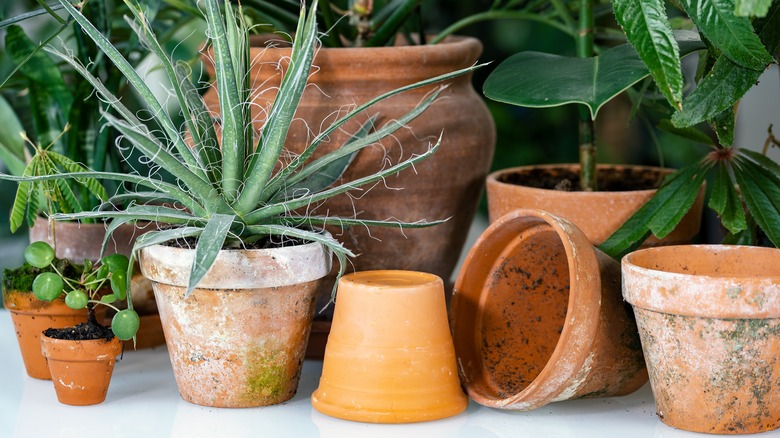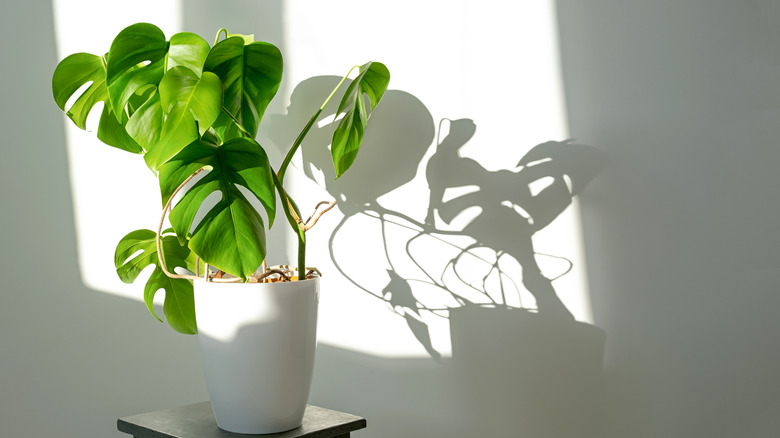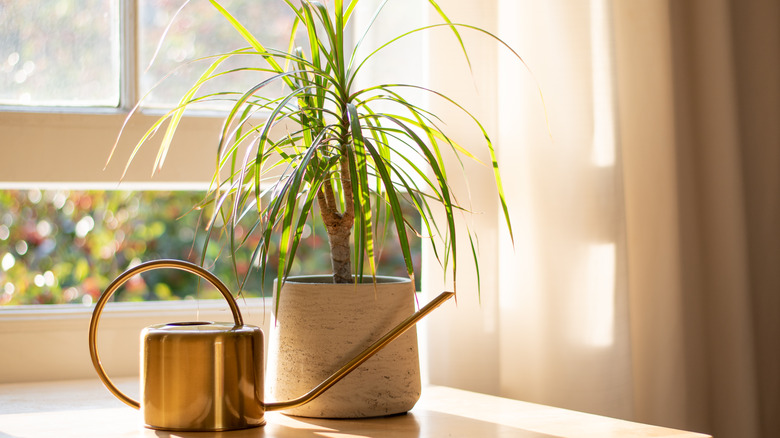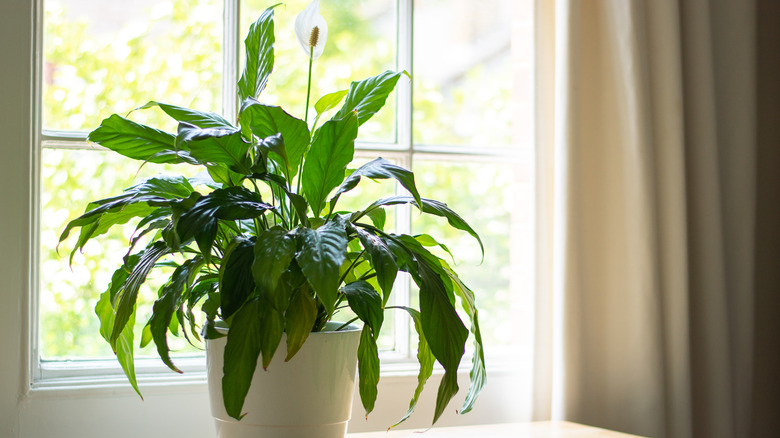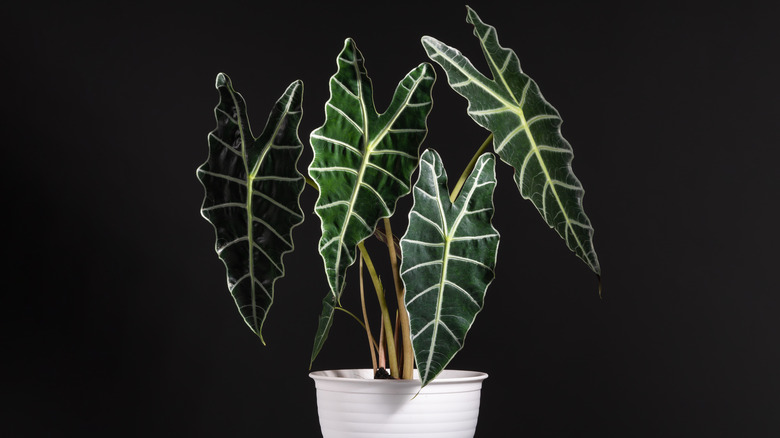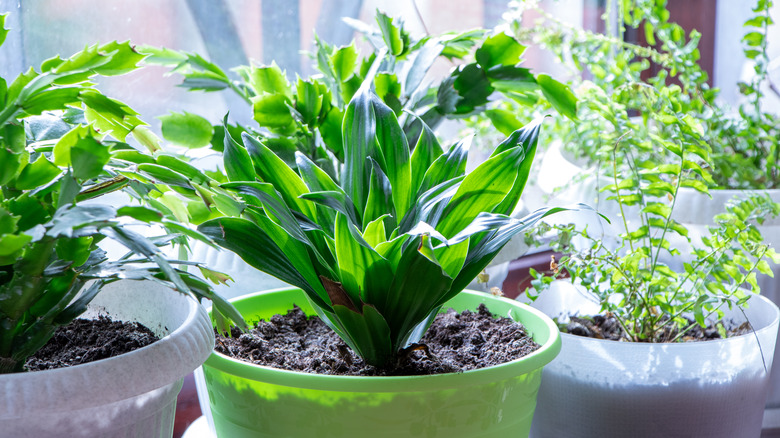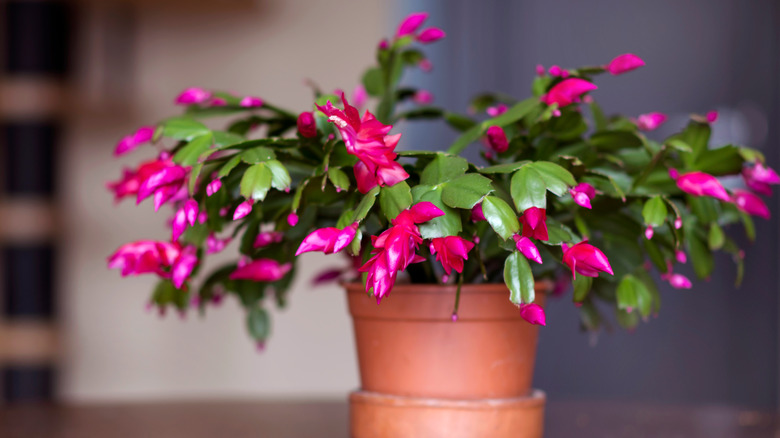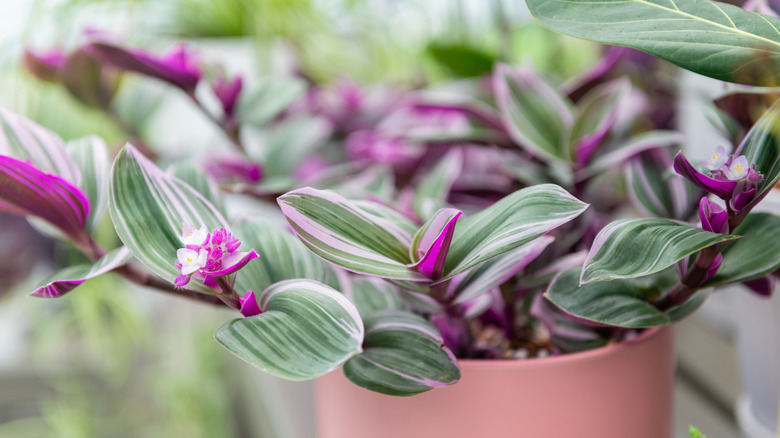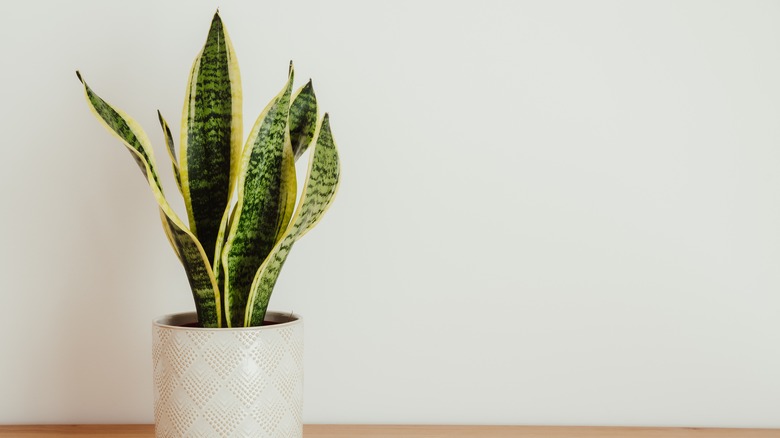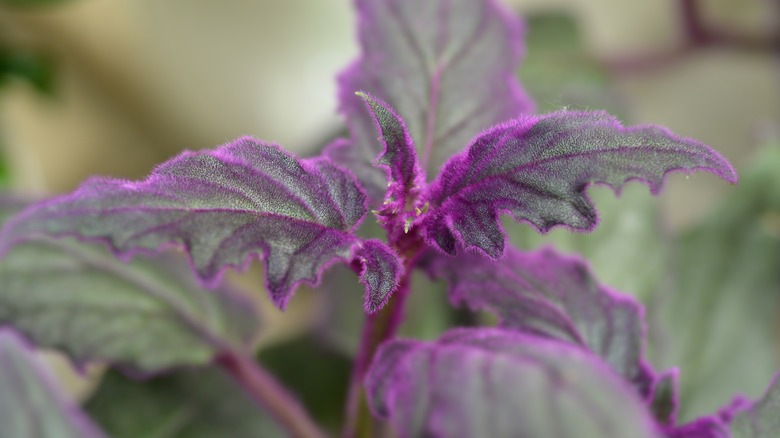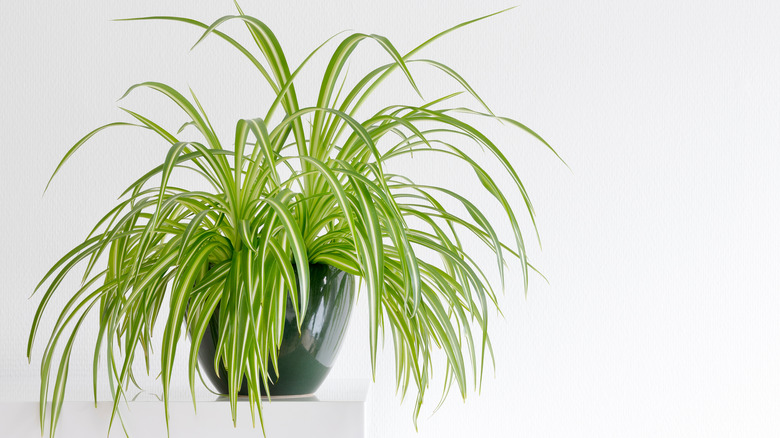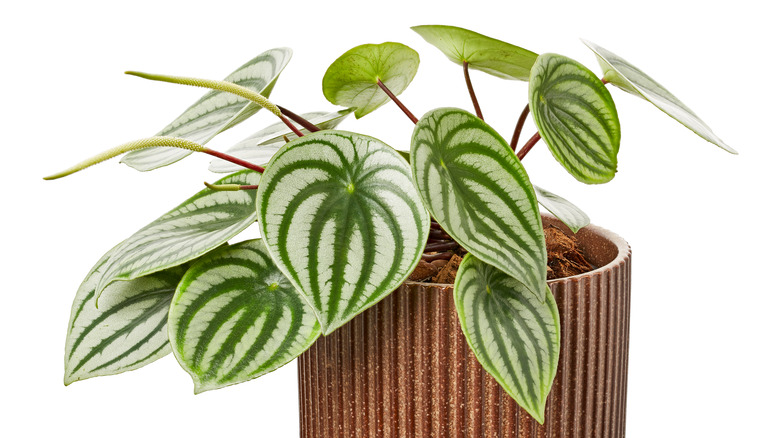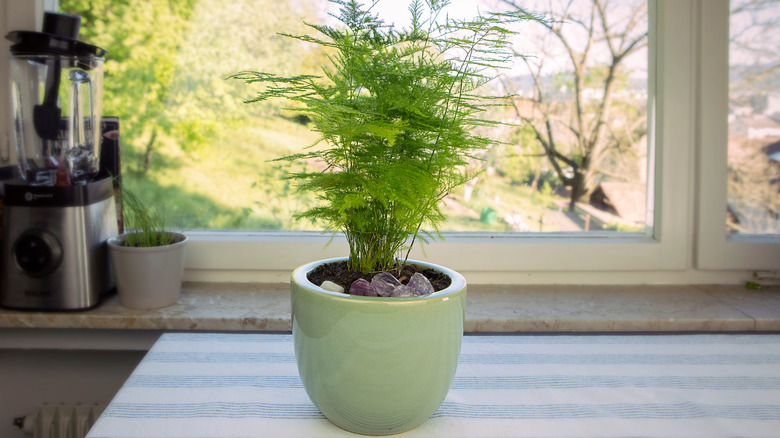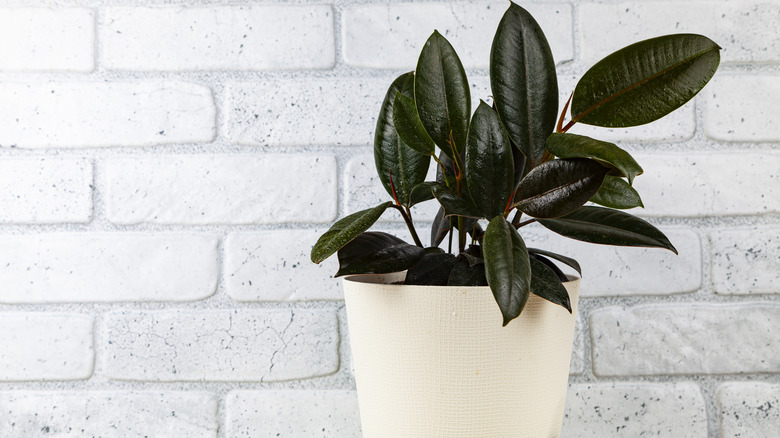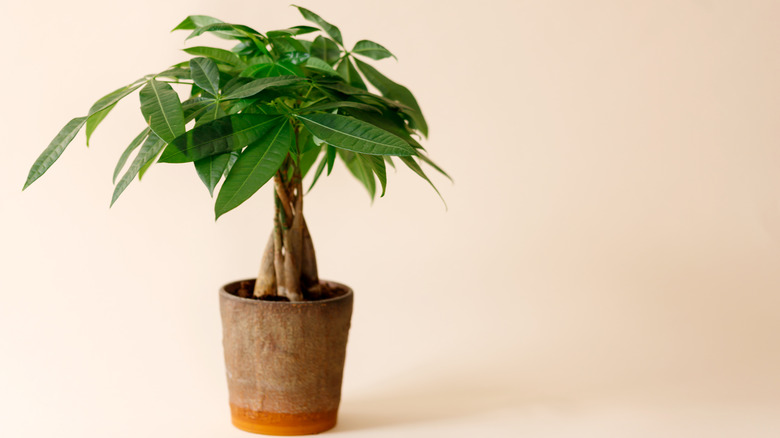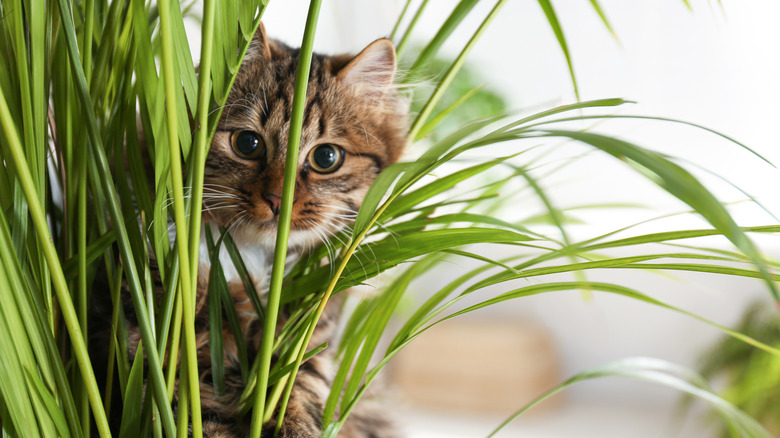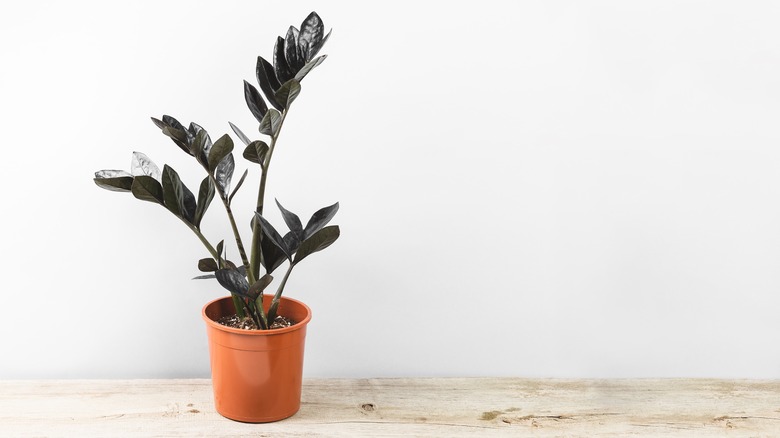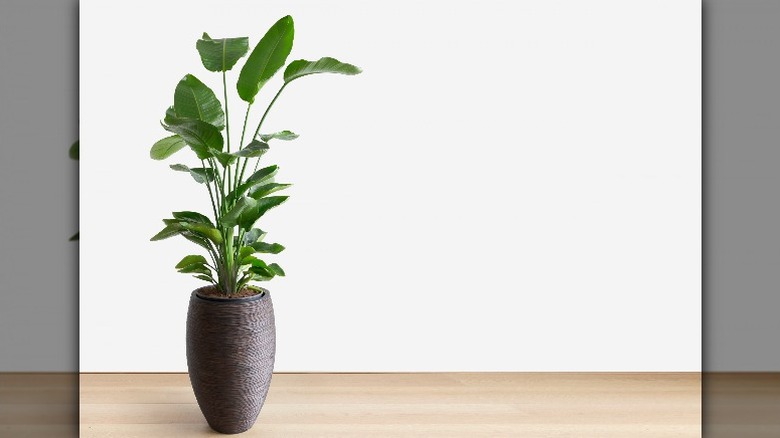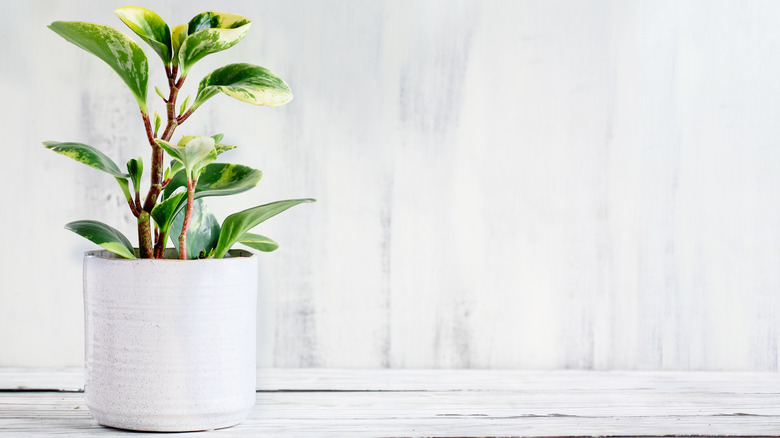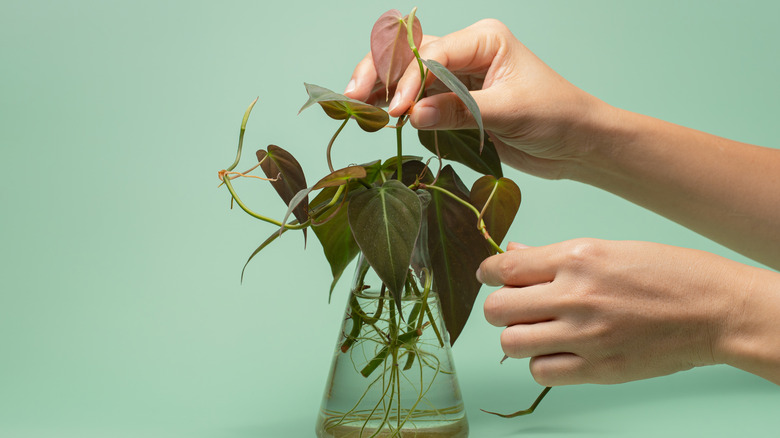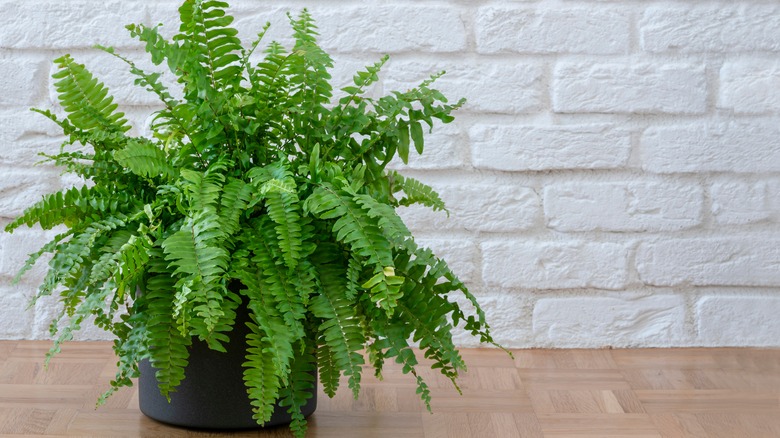20 Houseplants That Thrive In Medium Light
Knowing what type of sunlight you have in your home is essential when starting a plant collection. Too little sunlight will prevent your plants from photosynthesizing, and too much will burn their foliage. Finding out what direction your windows face is the best way to know how much light they will provide your plants. La Résidence magazine explains that west and south-facing windows let in bright, direct light. East-facing windows give bright, indirect light, and north-facing windows provide medium light. Low light is a room without windows or several feet from one.
There are many ways to give your medium-sun plants the proper amount of light. If your home is too bright, you can move your plants further from the window. You can also use sheer curtains to reduce the sun coming in. However, if you have a low-light room that needs supplemental sun, you can install grow lights. Your average lightbulbs will slightly help, but they don't have the spectrum of blue and red light required for plants to grow and flower.
1. Monstera
The monstera (Monstera deliciosa) is a tropical plant that grows up trees. To mimic this in your house, a moss stick in the pot will give your plant something to climb up. Doing this will help give your plant the perfect environment, so it can reward you with splits in its leaves. These splits give monsteras their nickname as the Swiss cheese plant, according to Greenery Unlimited. It needs water every one to two weeks and medium light. Rotating your plant will help all the leaves on your monstera grow evenly.
2. Dracaena
Dracaena (Dracaena marginata) is the perfect big houseplant because it grows tall like a small tree but doesn't need a big pot. It's also known as the Madagascar dragon tree because a red resin that looks similar to blood seeps out when it's damaged. To care for this plant, provide it with medium light and water it every one to two weeks. OurHouseplants.com explains that you'll know if your dracaena has too much sun if the foliage starts to burn. It's not getting enough light if new leaves grow small and limp.
3. Peace lily
Peace lilies (Spathiphyllum wallisii) not only have beautiful white blooms that brighten up homes, but they clean the air. Happy Sprout explains that they filter out acetone and alcohol particles from the air in your home as they photosynthesize. These chemicals come from things like nail polish remover, paint, and rubbing alcohol. Your peace lily should be watered weekly and kept in a humid environment. They don't like direct sunlight so keep them away from south-facing windows.
4. Elephant ear
Elephant ear plants (Alocasia) live up to the name because of their big triangle-shaped leaves. The foliage on this plant can grow so large that the pots tip over by the time you need to repot them. Greener House explains this is because their roots prefer a small cramped pot. Elephant ears need to be watered weekly and given indirect light. The large leaves will have brown or yellow burn marks if they get too much sun. Luckily, this plant grows quickly, so a dropped leaf won't be gone long before a new one takes its place.
5. Cast iron plant
Cast iron plants (Aspidistra elatior) have long dark green leaves that grow straight up. A mature plant can reach 3 feet tall. This plant is perfect for beginners because it thrives on neglect, according to The Houseplant Resource Center. It needs water about every 10 days. However, it's OK if you forget about your cast iron plant and it's underwatered for a bit. Dry soil is better than overwatering it and risking root rot. Medium light is best because any direct sun will burn it.
6. Christmas cactus
Christmas cactus (Schlumbergera) is a fun plant that blooms tiny pink flowers in the winter. This plant has unique foliage that droops down over the pot during the rest of the year. Unlike most cacti, the Christmas cactus can get stressed out from direct light. It needs water every one to three weeks, according to Empress of Dirt. To get flourishing blooms, give your plant a schedule of 12-14 hours of darkness every day and keep it in a room between 50 to 65 degrees Fahrenheit.
7. Inch plant
Inch plants (Tradescantia zebrina) get their nickname because some plant owners believe it grows an inch a day, according to Garden Betty. This plant is also great for beginners because it's low maintenance. It prefers indirect light but can handle full sun if you slowly acclimate it. The soil stays slightly moist, but overwatering can result in root rot. A sign that you're giving your inch plant too much water is if the leaves start turning yellow and limp.
8. Snake plant
Snake plants (Sansevieria trifasciata) are another air-purifying plant. When they photosynthesize, they can remove cancer-causing toxins like formaldehyde and benzene. This plant is known for its tall leaves that are shaped like swords. They have green variegation on them and a yellow outline. While this plant can live in low-light conditions, it'll lose its variegation, according to Gardeners' World. Medium, indirect light is best for snake plants. They also need water every one to two weeks.
9. Purple velvet plant
Purple velvet plants (Gynura aurantiaca) are unique vining houseplants with fuzzy purple leaves. The NC State Extension Gardener Plant Toolbox explains that the foliage on this plant looks like purple velvet because of the fine reddish-purple hairs. While the leaves are purple, the stems are dark red. It likes bright, indirect light and moist soil. Using well-draining soil and watering it once a week will keep the soil from being soggy and risking root rot.
10. Spider plant
Spider plants (Chlorophytum comosum) are another low-maintenance plant that's good for beginners. They have long slim leaves that grow from the stem like ribbons. All you have to worry about with this plant is watering it. You should water it weekly to keep the water moist, according to Patch Plants. Whether or not you fertilize it, it'll grow happily. Spider plants can live with low to bright, indirect light. If you want it to grow quicker, provide it with more light.
11. Watermelon peperomia
Watermelon peperomia (Peperomia argyreia) is one of the most popular peperomias. It looks similar to the pilea peperomia with coin-shaped leaves, but this variety has a green-and-silver pattern similar to watermelon rinds. This plant naturally grows under foliage, so it doesn't like direct sunlight. DIY & Houseplants With Brittany Goldwyn explains that too much sun will cause this peperomia to lose its distinctive pattern. It also needs to be watered weekly and should be in well-draining soil. Consider adding perlite or sand to your potting mix if it's retaining a lot of water.
12. Asparagus fern
Asparagus ferns (Asparagus seteceus) are as low maintenance as any other fern, but they actually aren't part of the fern genus. They're great for beginners because they have tuberous roots that store extra nutrients, according to mindbodygreen. This plant prefers a warm, humid location. It should get medium, indirect light and needs water every two to three weeks during the growing season. Cut the watering in half during the winter when asparagus ferns are dormant.
13. Rubber plant
Rubber plants (Ficus elastica) are the easiest ficus variety to take care of. They're known for their large waxy dark green leaves and red stems. The hardest part of taking care of this plant is making sure not to overwater it, which will kill it. You should water your rubber plant about every one to two weeks. They like the soil to stay moist but not wet (via Greenery Unlimited). Any drafty windows or heaters will also hurt your plant by drying it out.
14. Money tree
The money tree (Pachira aquatica) gets its name because it symbolizes prosperity. It's known for its brained trunk and can grow up to 8 feet tall. PlantSnap explains that money trees do best with indirect light but can tolerate some direct sunlight. They're sensitive to environmental changes, so once you have a spot for your plant, don't move it around a lot. Money plants also need a humid environment. You should water them about every three weeks and mist them.
15. Cat palm
Cat palms (Chamaedorea cataractarum) are great non-toxic plants to have in a house with cats, dogs, or children. They grow slowly but can reach 6 feet tall once they're mature, according to Houseplant 411. This palm doesn't like direct sunlight because it'll quickly dry the soil. They need a lot of humidity and prefer soil that's slightly moist all the time. It's best to water them one to two times a week.
16. Raven ZZ
Raven ZZ plants (Zamioculcas zamiifolia raven) are just as easy to take care of as the regular variation. This type is different because it grows dark purple leaves instead of green. However, the foliage grows like a typical ZZ plant and then changes color over the next two months, according to Nature & Garden. This is a hardy plant that will thrive when you forget about it. Its roots have rhizomes that hold extra moisture, so it can go months without being watered. ZZ plants can live with low light, but they grow faster with medium, indirect light.
17. Bird of paradise
The bird of paradise plant (Strelitzia reginae) gets its name from the shape of its flowers. When they bloom, the petals fan out and mimic a bird flying over the plant. Chatfield Court explains that this hardy plant can thrive in almost any home. If you water them weekly and provide the proper light, they will grow over 6 feet tall. Younger birds of paradise are better for homes with medium light, while mature plants need brighter light to produce flowers.
18. Baby rubber plant
Caring for a baby rubber plant (Peperomia obtusifolia) is easy. They're a nice addition to any houseplant collection because their green and yellow leaves curl like a funnel when they connect to the red stems of the plant. Medium to bright, indirect light is needed for a baby rubber plant to thrive. Humidity is also important, according to Houseplant Central. This plant prefers 40% to 50% humidity. It also likes moist soil, so water it weekly.
19. Philodendron micans
Philodendron micans (Philodendron hederaceum) are a dramatic variety with dark velvety green leaves that are purple on the underside. They're another tropical plant that loves having a moss pole in its pot to climb up. While this philodendron can tolerate low light, providing it with more indirect light will keep it from stretching out (via House Plant Hobbyist). It also needs well-draining soil and water about every one to two weeks. To prevent root rot, always check the soil's moisture before watering.
20. Boston fern
Boston ferns (Nephrolepis exaltata) are beginner-friendly plants. They add a lot of texture to your home's decor with their long bushy foliage that grows in every direction. To keep this plant looking perfect, you should place it in medium sunlight. The temperature of your home is also important because ferns need warmth and humidity. Heeman's explains that the leaves' tips turning brown indicates that the air is too dry. It likes moist soil, so water it at least once a week.
